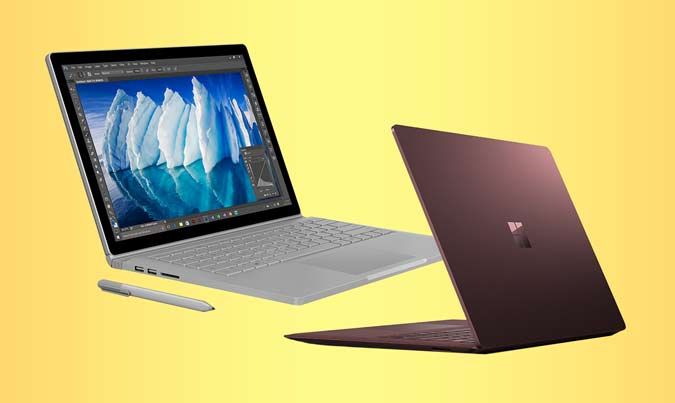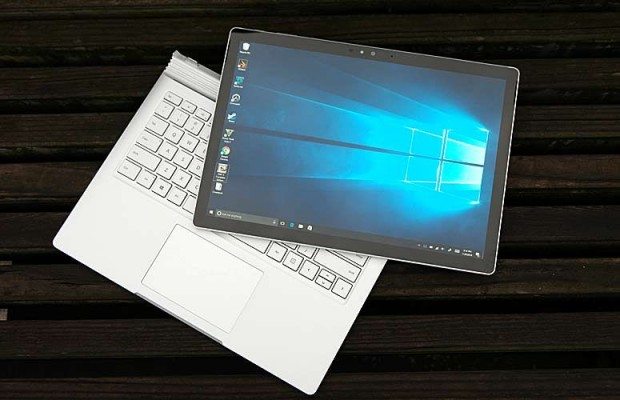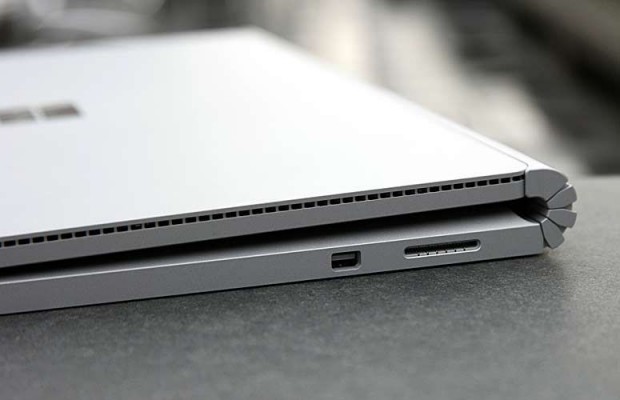Microsoft Surface Laptop vs. Surface Book: Which Is Right for You?
Of Microsoft’s two laptops, the newer Surface Laptop (starting at $999, available June 15) is getting all the buzz. It’s sleek, comes in a wide range of colors and features a soft Alcantara fabric that will turn heads. It’s also fairly well equipped for the price. However, the Surface Book (starting at $1,499) is the more versatile powerhouse, packing beefier specs and more ports in a detachable 2-in-1 design. The question isn’t which Microsoft laptop is better, but which one is better for you.

Surface Laptop vs. Surface Book: Specs
| Row 0 - Cell 0 | Microsoft Surface Laptop | Microsoft Surface Book |
| Price Range | $999 to $2,199 | $1,499 to $3,299 |
| Weight & Thickness | 2.8 pounds, 0.6 inches thick | 3.3 pounds, 0.9 inches thick |
| Colors | Platinum, burgundy, cobalt blue, graphite gold (colors other than platinum are available only at the $1,299 level) | Silver |
| Materials | Aluminum, Alcantara keyboard deck | Magnesium |
| Display | 13.5 inches, 2256 x 1504 | 13.5 inches, 3000 x 2000 |
| Ports | USB 3.0, mini DisplayPort, headphone jack | Two USB 3.0 ports, full-size SD card reader, mini DisplayPort, headphone jack |
| CPU | 7th Gen Core i5, Core i7 | 6th Gen Intel Core i5, Core i7 |
| RAM | 4GB, 8GB, 16GB | 8GB, 16GB |
| SSD | 128GB, 256GB, 512GB | 128GB, 256GB, 512GB, 1TB |
| Graphics | Intel HD 620, Iris Plus 640 | Intel HD 520, Nvidia GeForce GPU (1GB), Nvidia GeForce GTX 965M (2GB) |
| Special Features | Works with Surface Pen and Surface Dial | Works with Surface Pen (included) and Surface Dial. Detachable display |
Design
The Surface Laptop is built with form in mind, while the Surface Book is clearly all about function. The Surface Laptop is an all-around jaw-dropper, with an aluminum build just 0.6 inches thick; a classy, shiny Windows logo; and an Alcantara deck that’s soft, comfortable and reminiscent of a luxury car’s interior. All models of the Surface Laptop come in a platinum color, but if you get the $1,299 model, you can also choose from three additional colors: burgundy, cobalt blue and graphite gold.

The Surface Book, on the other hand, is a heavier 3.3 pounds and 0.9 inches thick. It’s not what you would expect from a typical laptop, thanks to its fulcrum hinge, with bendable treads that connect the display to the base. Otherwise, it’s plain and gray, though with sleek, rounded edges we’ve come to expect from premium notebooks. But the Surface Book has a unique feature that differentiates it from the Surface Laptop: The display disconnects and can be used as a tablet for drawing and inking. You can also flip it around backward into the dock, which lets you use it as a drawing pad or a display.
Display
Both the Book and the Laptop boast 13.5-inch displays, but the former pushes more pixels. The Surface Book has a resolution of 3000 x 2000, whereas the Surface Laptop’s is 2256 x 1504. This difference is so small that most people won’t notice it. Both screens support touch, including input from the Surface Pen and the Surface Dial. However, only the Book comes with the stylus.

The Surface Book is bright (387 nits) and vivid (it reproduced 98.5 percent of the sRGB color gamut), so we have high hopes for the Surface Laptop. We’ll see how it compares when it shows up in our labs.
MORE: Microsoft Surface Laptop vs Dell XPS 13: Face-off!
Ports
The Surface Book has two USB 3.0 ports, a full-size SD card reader, a mini DisplayPort and a headphone jack. That isn’t a ton of ports, but the selection is solid for most people. The Surface Laptop’s port selection is paltry by comparison. You get a single USB 3.0 port, a mini DisplayPort and a headphone jack — that’s it.
Sign up to receive The Snapshot, a free special dispatch from Laptop Mag, in your inbox.

Both machines use a proprietary connector for charging. That connector is also used to power the Surface Dock, an optional $200 peripheral. We would prefer to see a USB Type-C port on the Surface Laptop, as there’s a growing array of accessories available. (The Surface Book gets a pass for now because it’s an older design, but we’d like to see it show up there the next time it’s refreshed.)
Specs and Configuration Options
The Surface Laptop starts at $999, which gets you a 7th Generation Intel Core i5 CPU, 4GB of RAM and a 128GB SSD. However, we’d opt for the $1,299 model, which includes a roomier 256GB SSD and 8GB of RAM, as well as more color options.
For $1,599, you get a Core i7 CPU, 8GB of RAM and Intel Iris Plus 640 graphics. At $2,199, you’ll bump up to a 512GB SSD and 16GB of RAM.

The Surface Laptop also comes with Windows 10 S, which can download apps only from the Windows Store. For now, you can upgrade to Windows 10 Pro for free, but in 2018, you’ll have to pay an extra $50 for the privilege.
The Surface Book has far more configurations than the Surface Laptop. It starts at $1,499 for an older, 6th Generation Core i5 CPU, 8GB or RAM and a 128GB SSD. There are a variety of storage and RAM options, and then there’s the newer model with Performance Base, which includes a 6th-Gen Core i7 CPU and Nvidia GeForce GTX 965M graphics. That starts at $2,399 for 8GB of RAM and a 256GB SSD and ranges up to $3,299 for a 1TB SSD and 16GB of RAM. The high-octane configuration options for the Surface Book really illustrate the difference between these two machines. The Book is for creators who need to run powerful apps, whereas the Surface Laptop is for more average users.
Battery Life
The Surface Book lasted for 12 and a half hours on the Laptop Mag Battery Test, which continuously browses the web over Wi-Fi. That’s some serious endurance, but Microsoft promises that the Surface Laptop will run for a whopping 14.5 hours (at least with Windows 10 S). We’ll put the Surface Laptop to the test when it shows up in our labs.
What Should You Get?
Despite their similar names, the Surface Laptop and the Surface Book couldn’t be more different. Sure, they’re both are made by Microsoft, and both sport 13.5-inch screens. But that’s pretty much where the similarities end. The Surface Laptop is a high-end device for the MacBook Air crowd: students, young professionals and anyone who is mostly browsing the web, working on word processors or spreadsheets, and listening to music. The Surface Book, by contrast, is a creator’s device, with a stylus in the box for drawing and the power to run software such as Photoshop, thanks to its optional discrete GPU. Is one better than the other? Well, the Surface Book is more powerful. But the decision of which one is right for you will be based entirely on the type of work you do, your budget and how portable you want your notebook to be.
Images: Composite - Microsoft, Laptop Mag; Surface Laptop - Andrew E. Freedman / Laptop Mag; Surface Book - Sam Rutherford/Laptop Mag
Windows 10 Basics
- 7 Settings to Change Right Away
- Windows 10 Keyboard Shortcuts to Save You Clicks
- 5 Ways to Take Screenshots
- Change Your Password in Windows 10
- Uninstall Programs in Windows 10
- Enable or Disable Tablet Mode
- Add a User (Child or Adult)
- Change the Screen Resolution
- Sync Your Settings Across Devices
- Sync iPhone with Windows 10
- Control Windows 10 with Your Voice
- Upgrade to Windows 10 From Windows 7 or 8
- Eliminate Blue Light With Night Light
- Create a New Folder
- Get to the Desktop in Windows 10
- Add a Printer
- All Windows 10 Tips
- Set Alarms
Andrew is a contributing writer at Laptop Mag. His main focus lies in helpful how-to guides and laptop reviews, including Asus, Microsoft Surface, Samsung Chromebook, and Dell. He has also dabbled in peripherals, including webcams and docking stations. His work has also appeared in Tom's Hardware, Tom's Guide, PCMag, Kotaku, and Complex. He fondly remembers his first computer: a Gateway that still lives in a spare room in his parents' home, albeit without an internet connection. When he’s not writing about tech, you can find him playing video games, checking social media and waiting for the next Marvel movie.
